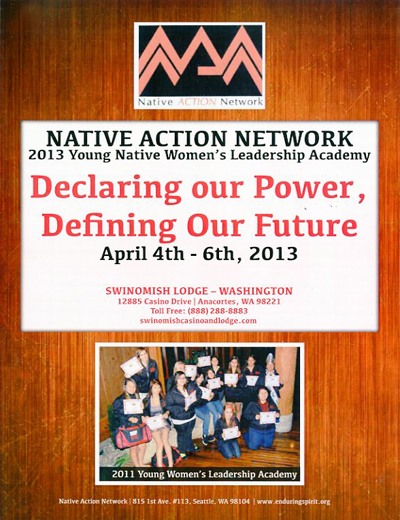When President Barack Obama signed the Violence Against Women Act earlier this month, he spoke of cracking down on domestic abuse in Indian Country, where the violent crime rate is more than 2.5 times the national rate and impunity is deeply entrenched.
“One of the reasons is that when Native American women are abused on tribal lands by an attacker who is not Native American, the attacker is immune from prosecution by tribal courts,” Obama said.
“Well, as soon as I sign this bill, that ends,” he said. “That ends.”
But for most tribes, closing that loophole against abusers will take time. For some, it may not happen at all.
The law has two provisions that already apply nationwide. Tribal governments can now enforce protection orders filed in state or federal court. The law also imposes stiffer penalties on anyone who inflicts substantial bodily injury on a partner, such as strangling or suffocation.
It’s the law’s controversial provision of trying non-Natives in Native court systems — one that initially held up its passage — that poses the challenge.
Tribal justice systems vary in their capabilities. On some reservations, attorneys and judges aren’t required to have a law degree. Defense attorneys may not be provided. Tribal law enforcement officers often don’t have the proper training to handle major crimes cases.
At the moment, no tribe has a system currently capable of enforcing the new law as it’s written. The law requires that tribes provide non-Native defendants with the same rights they would have in U.S. courts, including a right to an attorney, trained judges, and trial by their peers, meaning the court must at least attempt to include non-Indians in its jury pool.
“It’s Going to Start Small”
Only about 100 of the 566 federally recognized are likely to be able or interested in implementing the new protections over the next five years, according to John Dossett, the general counsel for the National Congress of American Indians, a D.C.-based group that represents the interests of Native Americans.
Of those, only 10 to 20 are likely to come into compliance in the next two years.
Many tribes are just too small to have their own justice systems and leave law enforcement to the state and federal authorities entirely. Others have remote reservations with few non-Native residents, so that prosecutorial power isn’t as much of a priority.
As always, there’s also the question of money. The law provides $5 million a year for five years — a total of $25 million — to help tribes strengthen their justice systems. That’s assuming Congress allocates the funding, which could be jeopardized by the sequester.
“The tribal criminal jurisdiction is more of a long-term project, and I think everyone understands that — I hope they do,” said Sam Hirsch, the deputy associate attorney general at the Justice Department’s Office of Tribal Justice.
Hirsch said the office will consult with the tribes before drawing up a written policy outlining the next steps, and work with those who want to take advantage of the new provision. The office will also help the tribes find the funding they need, he said.
“It’s going to start small, and it’s going to spread and build,” he said.
A Symbolic Victory
Even if only a few tribes enforce it, the law is important as a symbolic victory, said Sarah Deer, a professor at the William Mitchell College of Law in Minnesota and a tribal justice expert.
“It provides more options to tribes, and that’s what I think sovereignty is about, being able to make decisions that are best for your community,” she said. “The less federal intrusion we have in sovereignty, the better off Indian people are going to be.”
Tribal advocates pushed for this new legislation in part because without it, domestic violence crimes were left to the federal government to prosecute — which often didn’t happen.
The federal government declined to prosecute 50 percent of the cases in Indian country referred to U.S. attorneys from 2005 to 2009, according to a 2010 Government Accountability Report (pdf). That rate was higher for violent crimes, at about 52 percent. For sexual abuse, the rate was 67 percent.
Federal officials have said the high declination rates occur in part because evidence is difficult to come by, especially in assault cases, and witnesses are often reluctant or unwilling to testify.
According to a 2010 law, the Justice Department is required to report its declination rates for cases on Native American reservations to Congress, but has yet to report rates for recent years. A Justice Department spokesman said it would be filing a report to Congress with that information in April.
One federal prosecutor told FRONTLINE that the declination number for major crimes has since gone down, in part because cooperation between tribes and federal officials has improved, making it easier to gather the evidence needed to try and win cases. But he declined to provide specific figures.
One Tribe on the Fast-Track
For the most part, justice on the reservation for the Confederated Tribes of Umatilla in northeastern Oregon looks a lot like justice elsewhere in America.
Tribal law enforcement officers receive the same training as state police, and the judge has a law degree. Defense attorneys are provided for those who ask for them, and the tribe is able to prosecute major felonies. Those who are convicted serve their time in the county jail.
But when it comes to domestic violence, it’s almost as if the system doesn’t exist.
About half of the 3,000 people living on or near the Umatilla reservation are non-Native, many of them married to women from one of three tribes: the Cayuse, Umatilla and Walla Walla. Tribal officials have no jurisdiction over non-Native men on the reservation.
Women there often don’t even bother to report abuse, said Brent Leonhard, an attorney for the Confederated Tribes of Umatilla’s Office of Legal Counsel.
“There’s real reluctance because of the belief — which was correct — was that it wouldn’t be prosecuted, which just makes it more dangerous for the victim,” he said.
Leonhard said the lack of domestic violence prosecutions had led some to buy into the false belief that abuse doesn’t even exist on the reservation, further isolating victims and emboldening their abusers.
The law could change that.
At Umatilla, it’s a practical matter of updating the tribal code to allow the tribes’ courts to prosecute non-Indians. Under the Tribal Law and Order Act, passed in 2010, tribes were allowed to prosecute some felonies, and even to impose jail sentences of up to three years. Most tribes didn’t use the new power because their systems weren’t strong enough, and they lacked the funds to upgrade them.
But for the communities that did, like the Umatilla, their legal codes are current enough that they won’t need to make as many adjustments, Leonhard said.
Leonhard hopes to have the provisions in place by the end of the year. Then, he’ll petition the attorney general to expedite the process to begin prosecutions of non-Native abusers.
“I think, and I hope, it will make a very large difference,” he said.






 Congressman Rick Larsen
Everett Office
2930 Wetmore Avenue, Suite 9F
Congressman Rick Larsen
Everett Office
2930 Wetmore Avenue, Suite 9F





